 W
W3D Movie Maker is a children's computer program developed by Microsoft Home's Microsoft Kids subsidiary in 1995. Using the program, users can make films by placing 3D characters and props into pre-rendered environments, as well as adding actions, sound effects, music, text, speech and special effects. Movies are then saved in the .3mm file format.
 W
WMicrosoft Anti-Virus (MSAV) was an antivirus program introduced by Microsoft for its MS-DOS operating system. The program first appeared in MS-DOS version 6.0 (1993) and last appeared in MS-DOS 6.22. The first version of the antivirus program was basic, had no inbuilt update facility and could scan for 1,234 different viruses. Microsoft Anti-Virus for Windows (MWAV), included as part of the package, was a front end that allowed MSAV to run properly on Windows 3.1x.
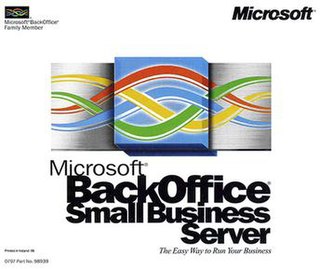 W
WMicrosoft BackOffice Server is a discontinued computer software package featuring Windows NT Server and other Microsoft server products that ran on NT Server. It was marketed during the 1990s and early 2000s for use in branch operations and for small businesses to run their back office operations. The small business edition of BackOffice Server was released for versions 4.0 and 4.5. In 2000 it was spun off from the "BackOffice" brand, becoming a variant of Windows Server branded as Windows Small Business Server. BackOffice Server itself was discontinued on October 1, 2001.
Microsoft Bob was a Microsoft software product that was released on March 11, 1995 and discontinued in early 1996. The program was intended to provide a more user-friendly interface for the Windows 3.1x, Windows 95 and Windows NT operating systems, supplanting the Windows Program Manager. Microsoft Bob presented screens showing a "house", with "rooms" that the user could go to containing familiar objects corresponding to computer applications—for instance, a desk with pen and paper, a checkbook, and other items. In this case, clicking on the pen and paper would open the word processor.
 W
WMicrosoft Bookshelf was a reference collection introduced in 1987 as part of Microsoft's extensive work in promoting CD-ROM technology as a distribution medium for electronic publishing. The original MS-DOS version showcased the massive storage capacity of CD-ROM technology, and was accessed while the user was using one of 13 different word processor programs that Bookshelf supported. Subsequent versions were produced for Windows and became a commercial success as part of the Microsoft Home brand. It was often bundled with personal computers as a cheaper alternative to the Encarta Suite. The Encarta Deluxe Suite / Reference Library versions also bundled Bookshelf.
 W
WCreative Writer is a word processor released by Microsoft Kids in 1993. Using this program, which is specifically targeted at children, it is possible to create documents such as letters, posters, flyers and stories complete with different fonts, Clip art, WordArt and effects. The interface and environment is especially targeted towards children and is set in Imaginopolis with the main helper being a character known as McZee. A sequel, Creative Writer 2, was released in 1996. Both are now discontinued, but can still be acquired from online stores and auction websites such as eBay.
 W
WCreative Writer 2, known as Mon Atelier d'Écriture in French and Junior Schreibstudio in German, was a word processing program released in 1996 by Microsoft Kids. The interface was updated and the program was now designed for Windows 95.
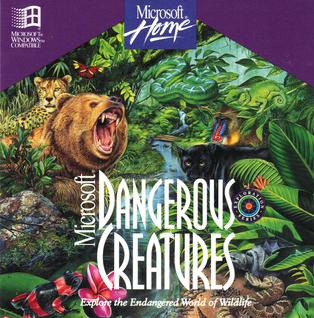 W
WMicrosoft Dangerous Creatures is a discontinued educational programme by Microsoft Home. It was designed for Windows 3.1 and first published in August 1994. It was included in the "Microsoft Home bundle pack" along with 'Encarta', 'Works Multimedia', Money and 'Arcade & Best of Windows Entertainment Pack'.
 W
WMicrosoft Diagnostics (MSD) was a software tool developed by Microsoft to assist in the diagnostics of 1990s-era computers. Users primarily deployed this tool to provide detailed technical information about the user's software and hardware and to print the gathered information, usually for use by support technicians in troubleshooting and resolving problems. The assumptions made by the program were valid until the late 1990s: it does not handle plug-and-play USB or other new technologies that appeared around 2000.
 W
WDirectX Media is a set of multimedia-related APIs for Microsoft Windows complementing DirectX.
 W
WMicrosoft Encarta was a digital multimedia encyclopedia published by Microsoft Corporation from 1993 to 2009. Originally sold on CD-ROM or DVD, it was also available on the World Wide Web via an annual subscription, although later articles could also be viewed free online with advertisements. By 2008, the complete English version, Encarta Premium, consisted of more than 62,000 articles, numerous photos and illustrations, music clips, videos, interactive content, timelines, maps, atlases and homework tools.
 W
WMicrosoft Entertainment Pack is a collection of 16-bit casual computer games for Windows. There were four Entertainment Packs released between 1990 and 1992. These games were somewhat unusual for the time, in that they would not run under MS-DOS. In 1994, a compilation of the previous four Entertainment Packs were released called The Best of Microsoft Entertainment Pack. A Game Boy Color version was released in 2000.
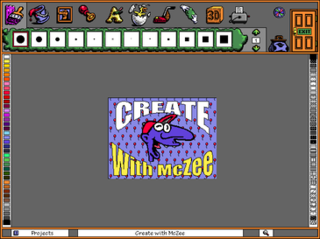 W
WFine Artist is a raster graphics editor program created by Microsoft Kids in 1993. Using this program, it is possible to create paintings. The interface and environment is especially targeted towards children and is set in Imaginopolis with the main helper being a character known as McZee. Fine Artist was announced by Microsoft on 7 December 1993 and was released in 1994. It ran on both MS-DOS 3.2 and the Windows 3.1 operating system. A version for Apple Macintosh was also released. Fine Artist is discontinued, but can still be acquired from online stores and auction websites such as eBay.
 W
WMicrosoft Home was a line of software applications and personal hardware products published by Microsoft. Microsoft Home software titles first appeared in the middle of 1993. These applications were designed to bring multimedia to Microsoft Windows and Macintosh personal computers. With more than 60 products available under the Microsoft Home brand by 1994, the company's push into the consumer market took off. Microsoft Plus!, an add-on enhancement package for Windows, continued until the Windows XP era. The range of home software catered for many different consumer interests from gaming with Microsoft Arcade and Entertainment Packs to reference titles such as Microsoft Encarta, Bookshelf and Cinemania. Shortly after the release of Microsoft Windows 95, the company began to reduce the price of Microsoft Home products and by the rise of the World Wide Web by 1998, Microsoft began to phase out the line of software.
 W
WInternet Explorer is a series of graphical web browsers developed by Microsoft and included in the Microsoft Windows line of operating systems, starting in 1995. It was first released as part of the add-on package Plus! for Windows 95 that year. Later versions were available as free downloads, or in-service packs, and included in the original equipment manufacturer (OEM) service releases of Windows 95 and later versions of Windows. New feature development for the browser was discontinued in 2016 in favour of their new browser Microsoft Edge. Since Internet Explorer is a Windows component and is included in long-term lifecycle versions of Windows such as Windows Server 2019, it will continue to receive security updates until at least 2029. Microsoft announced in August 2020 that as of August 2021, web-based Microsoft 365 products will no longer support Internet Explorer, with support for Microsoft Teams ending earlier in November 2020.
 W
WInternet Explorer for Mac OS X is a proprietary web browser developed by Microsoft for the Macintosh platform to browse web pages. Initial versions were developed from the same code base as Internet Explorer for Windows. Later versions diverged, particularly with the release of version 5 which included the cutting edge, fault-tolerant and highly standards-compliant Tasman layout engine.
Internet Explorer for UNIX is a discontinued version of the Internet Explorer graphical web browser that was available free of charge and produced by Microsoft for use in the X Window System on Solaris or HP-UX. Development ended with a version of Internet Explorer 5 in 2001 and support for it was completely discontinued in 2002.
 W
WMicrosoft Mail was the name given to several early Microsoft e-mail products for local area networks, primarily two architectures: one for Macintosh networks, and one for PC architecture-based LANs. All were eventually replaced by the Exchange and Outlook product lines.
 W
WMicrosoft MapPoint is a discontinued software program and service created by Microsoft that allows users to view, edit and integrate maps. The software and technology are designed to facilitate the geographical visualization and analysis of either included data or custom data. Numerous acquisitions have supplemented both data and feature integration.
 W
WMicrosoft Classroom was an online blended learning platform for schools that aimed to simplify grading assignments and student communication in a paperless way. It was introduced for Office 365 Education subscribers in April 2016.
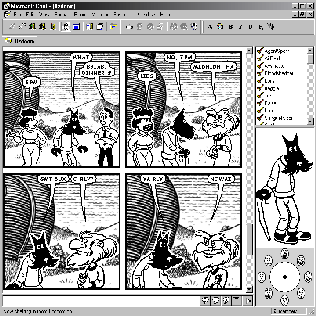 W
WMicrosoft Comic Chat is a graphic IRC client created by Microsoft, first released with Internet Explorer 3.0 in 1996. Comic Chat was developed by Microsoft Researcher David Kurlander, with Microsoft Research's Virtual Worlds Group and later a group he managed in Microsoft's Internet Division.
 W
WMicrosoft Expression Design was Microsoft's commercial professional illustration vector and raster graphic design tool for web images based on Creature House Expression, which was acquired by Microsoft in 2003. It is available free of charge from Microsoft and is component of the discontinued Microsoft Expression Studio suite. Expression Design is more oriented towards editing XAML and web graphics rather than print graphics and does not incorporate all of the raster image editing features of the original Creature House Expression.
 W
WMicrosoft Expression Encoder is a transcoding and non-linear video editing software application for Microsoft Windows. It can create video streams for distribution via Microsoft Silverlight. This utility is created to record the screen for various purposes like YouTube, Twitch, Sharing etc.
 W
WPhase One Media Pro was a commercial digital asset management cataloging program for Microsoft Windows and Apple OS X operating systems. It was the next version of iView MediaPro which Microsoft acquired in June 2006, and sold again in May 2010 to Phase One, which also makes the Capture One raw converter software. The software was aimed at professionals and photo enthusiasts who needed a photo manager which made it easier to manage photo and video assets, especially very large resolution image files and libraries with many items.
 W
WMicrosoft Expression Web is an HTML editor and general web design software product by Microsoft. It was discontinued on December 20, 2012 and subsequently made available free of charge from Microsoft. It was a component of the also discontinued Expression Studio.
 W
WMicrosoft FrontPage is a discontinued WYSIWYG HTML editor and website administration tool from Microsoft for the Microsoft Windows line of operating systems. It was branded as part of the Microsoft Office suite from 1997 to 2003. Microsoft FrontPage has since been replaced by Microsoft Expression Web and SharePoint Designer, which were first released in December 2006 alongside Microsoft Office 2007, but these two products were also discontinued in favor of a web-based version of SharePoint Designer, as those three HTML editors were desktop applications.
 W
WMicrosoft GIF Animator is a historical computer software program for Microsoft Windows to create simple animated GIF files based on the GIF89a file format. It was freely downloadable from the Microsoft Download Center but is now only available through MSDN and on third party download sites. It was also bundled with Microsoft Image Composer and Microsoft FrontPage.
 W
WMicrosoft Office Picture Manager is a raster graphics editor introduced in Microsoft Office 2003 and included up to Office 2010. It is the replacement to Microsoft Photo Editor introduced in Office 97 and included up to Office XP.
 W
WMicrosoft WebMatrix is a discontinued cloud-connected website builder and HTML editor for Windows, geared towards web development. WebMatrix enables developers to build websites using built-in templates or popular open-source applications, with full support for ASP.NET, PHP, Node.js and HTML5. Microsoft developed WebMatrix for the purpose of providing web developers with coding, customization, and publishing capabilities all in one place.
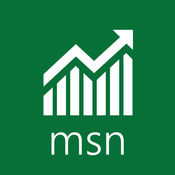 W
WMicrosoft Money is a personal finance management software program by Microsoft. It has capabilities for viewing bank account balances, creating budgets, and tracking expenses, among other features. It was designed for computers using the Microsoft Windows operating system, and versions for Windows Mobile were also available. Microsoft developed Money to compete with Quicken, another personal finance management software.
 W
WMicrosoft Photo Editor is a raster graphics editor component of Microsoft Office first included with Microsoft Office 97. It features editing tools to texturize, create negatives, adjust gamma, and add transparency to GIF images. It was replaced in Microsoft Office 2003 by Microsoft Office Picture Manager, although many Photo Editor features were not available in Picture Manager.
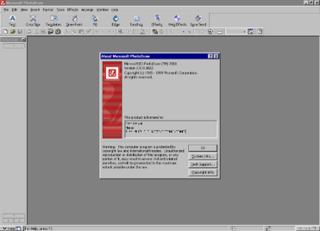 W
WMicrosoft PhotoDraw 2000 is a discontinued vector graphics and raster imaging software package developed by Microsoft.
 W
WPhotosynth is a discontinued app and service from Microsoft Live Labs and the University of Washington that analyzes digital photographs and generates a three-dimensional model of the photos and a point cloud of a photographed object. Pattern recognition components compare portions of images to create points, which are then compared to convert the image into a model. Users are able to view and generate their own models using a software tool available for download at the Photosynth website.
 W
WQuick View is a file viewer in Windows 95, Windows 98 and Windows NT 4.0 operating systems. The viewer can be used to view practically any file.
 W
WMicrosoft Reader is a discontinued Microsoft application for reading e-books, first released in August 2000, that used its own .LIT format. It was available for Windows computers and Pocket PC PDAs. The name was also used later for an unrelated application for reading PDF and XPS files, first released with Windows 8 - this app was discontinued in 2018.
 W
WMicrosoft Sort is a software utility developed by the Microsoft Corporation in 1982-83. It was sold in two versions - as a standalone utility and as a version hosted in Microsoft COBOL.
 W
WMicrosoft Streets & Trips, known in other countries as Microsoft AutoRoute, is a discontinued mapping program developed and distributed by Microsoft. Functionally, the last version is a subset of Microsoft MapPoint targeted at the average consumer to do a variety of map related tasks in the North American region including the United States, Canada, and Mexico, such as route planning.
 W
WSystem Policy Editor is a graphical tool provided with Windows 95, Windows NT 4.0, and Windows 98. System policies are made up from a set of registry entries that control the computer resources available to a user or group of users. These registry entries can be applied to individual users, groups of users, or to anybody logging on to a particular computer.
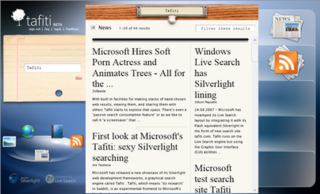 W
WTafiti was an animated search engine launched by Microsoft Corp. and TrappsInteractive to showcase the Silverlight animation and video player.
 W
WUrban Assault is a 3D combined first-person shooter and real-time strategy computer game developed by the German company TerraTools and published by Microsoft. It was released on August 18, 1998.
 W
WMicrosoft V-Chat is a freeware 3D chat program released in December 1995 by Microsoft. V-Chat is a multi-user social chat client that lets people interact online from within a 2D or 3D multimedia environment using graphical representations of themselves known as avatars. V-Chat avatars have a full range of gestures that allow users to fully express themselves online. V-Chat enables users to select from a wide variety of existing avatars, or create custom avatars using the V-Chat Avatar Wizard. Sounds, animations, and visual imagery create mood and context for these graphical social environments.
 W
WVisual FoxPro was a Microsoft data-centric procedural programming language that subsequently became object-oriented.
 W
WMicrosoft Vizact 2000 is a discontinued program that allowed creation of interactive documents using HTML+TIME, adding effects such as animation. It allowed users to create dynamic documents for the Web. It was preceded by Liquid Motion. Vizact 2000 was "the first document activation application" according to Microsoft. Development of Vizact 2000 was ended due to unpopularity and was discontinued on April 1, 2000."Vizact helps solve this problem by giving Office users the ability to create documents that harness the dynamic nature of the Web, without having to be Web authors or programmers." Karl Jacob, product unit manager of Microsoft's Document Activation Group.
 W
WWindows Essentials is a discontinued suite of Microsoft freeware applications that includes email, instant messaging, photo sharing, blogging, and parental control software. Essentials programs are designed to integrate well with each other, with Microsoft Windows, and other Microsoft web-based services such as OneDrive and Outlook.com.
 W
WInternet Explorer is a series of graphical web browsers developed by Microsoft and included in the Microsoft Windows line of operating systems, starting in 1995. It was first released as part of the add-on package Plus! for Windows 95 that year. Later versions were available as free downloads, or in-service packs, and included in the original equipment manufacturer (OEM) service releases of Windows 95 and later versions of Windows. New feature development for the browser was discontinued in 2016 in favour of their new browser Microsoft Edge. Since Internet Explorer is a Windows component and is included in long-term lifecycle versions of Windows such as Windows Server 2019, it will continue to receive security updates until at least 2029. Microsoft announced in August 2020 that as of August 2021, web-based Microsoft 365 products will no longer support Internet Explorer, with support for Microsoft Teams ending earlier in November 2020.
 W
WWindows Live Mail was a freeware email client from Microsoft. It is the successor to Windows Mail in Windows Vista, which was the successor to Outlook Express in Windows XP and Windows 98. Windows Live Mail is designed to run on Windows 7 and Windows Server 2008 R2, but is also compatible with Windows 8 and Windows 10, even though Microsoft bundles a new email client, named Windows Mail, with the latter.
 W
WMSN Messenger, later rebranded as Windows Live Messenger, was a cross-platform instant messaging client developed by Microsoft. It connected to the Microsoft Messenger service while also having compatibility with Yahoo! Messenger and Facebook Messenger. The client was first released as MSN Messenger Service on July 22, 1999, and was marketed under the MSN branding until 2005 when it was rebranded under Windows Live. It has since been officially known by its second name, although its first name was still used colloquially by most of its users. In June 2009, Microsoft reported the service attracted over 330 million active users each month, placing Messenger among the most widely used instant messaging clients in the world.
 W
WWindows Movie Maker is a discontinued video editing software program by Microsoft. It was a part of Windows Essentials software suite and offered the ability to create and edit videos as well as to publish them on OneDrive, Facebook, Vimeo, YouTube, and Flickr.
 W
WMicrosoft Works was a productivity software suite developed by Microsoft and sold from 1987 to 2009. Its core functionality included a word processor, a spreadsheet and a database management system. Later versions had a calendar application and a dictionary while older releases included a terminal emulator. Works was available as a standalone program, and as part of a namesake home productivity suite. Because of its low cost, companies frequently pre-installed Works on their low-cost machines. Works was smaller, less expensive, and had fewer features than Microsoft Office and other major office suites available at the time.